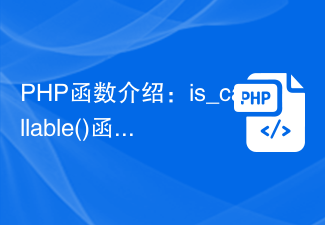Found a total of 10000 related content

How to use some function to check if at least one element in an array satisfies a condition?
Article Introduction:In JavaScript programming, when we need to check whether at least one element in an array meets a specific condition, we can use the some function. This function accepts a callback function as parameter, which is run on each element in the array and returns a Boolean value indicating whether the element meets the condition. Some function returns true if at least one element satisfies the condition, otherwise it returns false. A sample code is shown below: //Create an array constnums=[
2023-11-18
comment 0
1433

C++ function overloading and function virtual functions
Article Introduction:Answer: Function overloading and function virtual functions in C++ allow developers to create functions with the same name but different parameter lists or behaviors. Detailed description: Function overloading: Create functions with the same name but different parameter lists to use functions with similar functionality in different situations. Function virtual function: A function that overrides the base class in a derived class and is used for polymorphism, allowing the derived class to provide a different implementation than the base class.
2024-04-15
comment 0
451

What is the difference between PHP functions and Scala functions?
Article Introduction:PHP and Scala functions have the following key differences: Syntax: PHP uses function, Scala uses def, and the latter requires type annotations. Type annotations: Scala enforces type annotations, PHP does not. Default value: PHP can use optional parameters, and Scala can use Some()/None() to wrap default values. Type safety: Scala enforces type safety, PHP does not. Side effects: PHP functions have side effects, but Scala functions do not. Overloading: PHP supports overloading, Scala does not.
2024-04-25
comment 0
930

Anonymous function for golang function
Article Introduction:Go language anonymous functions can be used to create one-time-use functions or parts of larger functions without declaring a function name. Its syntax is func(){//function body}, which accepts parameters and return results. Practical examples include sorting slices (sorting by specific attributes through the sort.Slice function and anonymous functions) and filtering data (filtering odd numbers through the filter function and anonymous functions).
2024-04-20
comment 0
755

How to use some function
Article Introduction:The some() function is used to check whether at least one element in the array satisfies the parameter function check condition. Its usage syntax is "arr.some(arg_function(element, index, array), thisArg)".
2019-02-15
comment 0
8870

Oracle数据库函数(单行函数)
Article Introduction:Oracle中的函数和C中的函数差不多,也是有函数名,参数表,和返回值类型组成的,单行函数,是针对每条记录都有一个结果。单行函数
2016-06-07
comment 0
1072

Introduction to PHP functions: shuffle() function
Article Introduction:PHP function introduction: shuffle() function In PHP programming, the shuffle() function is a very useful function, which is used to disrupt the order of elements in an array. This article will introduce readers to the specific usage of the shuffle() function and provide some code examples to help readers better understand and apply this function. The syntax of the shuffle() function is as follows: shuffle(array&$array):bool This function accepts an array parameter $array and
2023-11-04
comment 0
2033

PHP function introduction: array_merge() function
Article Introduction:PHP function introduction: array_merge() function, specific code examples are required. PHP is a powerful programming language. It has countless built-in functions. Each function in the function library has its own unique purpose and effect. This article will introduce a very commonly used function in PHP, which is the array_merge() function. The array_merge() function is a function used to merge two or more arrays. It merges the elements of two or more arrays into one array and returns a new array. a
2023-11-03
comment 0
1728

PHP function introduction: is_callable() function
Article Introduction:PHP function introduction: is_callable() function In PHP, the is_callable() function is used to check whether a function or method is callable. It returns a boolean value, true if callable, false otherwise. This function is very useful when calling functions or methods dynamically. It can help us check whether the function or method exists before calling it. The is_callable() function can accept one parameter or two parameters. When there is only one argument, the function checks
2023-11-03
comment 0
860

Introduction to PHP functions: is_float() function
Article Introduction:PHP function introduction: is_float() function In PHP programming, the is_float() function is used to detect whether a variable is a floating point number (that is, a decimal). This article will introduce the syntax, usage and sample code of the is_float() function in detail. 1. Function syntax is_float(mixed$var): The boolis_float() function accepts a parameter $var, which can be any type of variable. The function returns a boolean value if $var
2023-11-04
comment 0
1566

Lambda function for PHP function
Article Introduction:In PHP, a Lambda function is also called an anonymous function, which refers to a function that does not have an identifier. Lambda functions are also common in other programming languages, such as Python and JavaScript. Compared with regular functions, Lambda functions are more flexible and easier to use. PHP and other programming languages provide Lambda functions to allow programmers to handle complex logical operations more easily. Lambda function is a new feature introduced in PHP5.3 version. Its syntax is relatively concise and can
2023-05-18
comment 0
1843

PHP function introduction: array_key_first() function
Article Introduction:Introduction to PHP functions: array_key_first() function PHP is a widely used server-side scripting language, and functions are an integral part of PHP programming. In the PHP function library, the array_key_first() function is a practical function introduced in PHP7.3. Its function is to get the first key name of the array. The syntax of the array_key_first() function is as follows: array_key_first(array
2023-11-04
comment 0
1480

Introduction to PHP functions: array() function
Article Introduction:Introduction to PHP functions: array() function and sample code Introduction: In PHP, the array() function is a very commonly used function, used to create an array. It can receive any number of parameters and create an array based on the values of the parameters. In this article, I will introduce you to the usage of the array() function and sample code to help you better understand and use it. Function overview: The array() function is one of PHP's built-in functions, used to create an array. It can receive any number of parameters and based on
2023-11-04
comment 0
1858

Introduction to PHP functions: time() function
Article Introduction:PHP function introduction: time() function PHP is a commonly used server-side programming language with powerful function library support. Among them, the time() function is one of the commonly used time functions in PHP. This article will introduce in detail the role, usage and specific code examples of the time() function. 1. The role of the time() function The time() function is a function built into PHP, used to obtain the current Unix timestamp (that is, from January 1, 1970 00:00:00UTC to the current
2023-11-03
comment 0
2466
php trim函数 ltrim函数 rtrim函数的差异
Article Introduction:
php trim函数 ltrim函数 rtrim函数的区别 大家都知道php的trim()函数,ltrim()函数,rtrim()函数都可以去除掉空格,那么三者在用法上有什么不同的区别那?现在就来为大家一一介绍一下。1.php trim()函数是去掉所有的空格(其实准确的来说是去掉字符串两次的所有空格),例如:$str=" love 59biye
2016-06-13
comment 0
1309

Data display function of PHP function
Article Introduction:PHP is a widely used programming language. One of its advantages is that it has a rich function library. These functions can greatly simplify the work of developers and make development work more efficient. Among them, the data display function of PHP function is very useful in data processing and display. PHP functions' data display functions provide a convenient way to display and manipulate data, such as arrays, objects, and strings. Some of the commonly used functions are introduced below. print_r() The print_r() function is a very commonly used data display
2023-05-18
comment 0
1356

Introduction to PHP functions: in_array() function
Article Introduction:PHP function introduction: in_array() function PHP is a commonly used server-side scripting language that provides a wealth of built-in functions to simplify the development process. Among them, the in_array() function is a very useful function for determining whether a specified value exists in the array. This article will introduce the usage of in_array() function in detail and provide specific code examples. 1. Basic usage of in_array() function The in_array() function is used to search for a specified value in an array and return a
2023-11-04
comment 0
1966

What is the difference between Java functions and C# functions?
Article Introduction:The difference between Java functions and C# functions: Syntax: Java functions start with a lowercase letter, and C# functions start with an uppercase letter. Parameter passing: Java functions use value passing, and C# functions use reference passing. Return type: Java functions can return any type, C# functions must specify the return type in the function signature.
2024-04-24
comment 0
880

PHP function introduction: str_word_count() function
Article Introduction:Introduction to PHP functions: str_word_count() function and code examples 1. Overview In PHP, the str_word_count() function is used to count the number of words in a string. This article will introduce the usage of this function in detail and give corresponding code examples. 2. Function syntax str_word_count(string$string[,int$format=0[,string$charlist]]) parameter description:
2023-11-04
comment 0
1362

How do PHP functions call other functions?
Article Introduction:In PHP, you can call other functions using the call_user_func() function, which requires two parameters: the function name and an array containing the function parameters. Define the function name to be called. Put the function parameters into an array. Use call_user_func() to call the function.
2024-04-11
comment 0
677


















